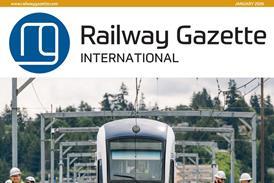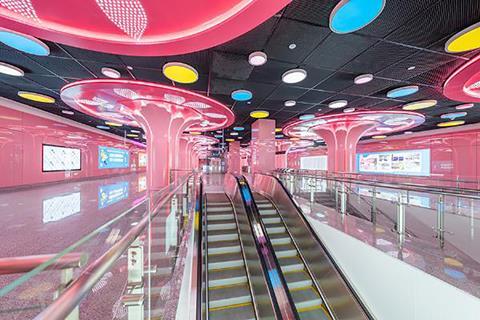
CHINA: Seven Chinese cities opened new metro lines, suburban railways or route extensions on December 28, totalling almost 211 km and adding 107 stations.
Designed for driverless operation at up to 120 km/h, Shenzhen Line 20 runs entirely underground, connecting Airport North to Convention & Exhibition City. Construction of the 8·4 km line with five stations began in October 2016, but the work was suspended from late 2018 to early 2020. Line 20 is worked by a fleet of nine eight-car Type A trainsets manufactured by CRRC Changchun. These are fitted with airtight doors to minimise the pressure pulses when trains pass at full speed in the tunnels. They are equipped with GoA4 autonomous driving technology based on vehicle-to-vehicle communication.
The Line 20 trains have their own stabling facility at Airport North, although the intention is that heavy maintenance will be undertaken at the adjacent Line 11 depot.
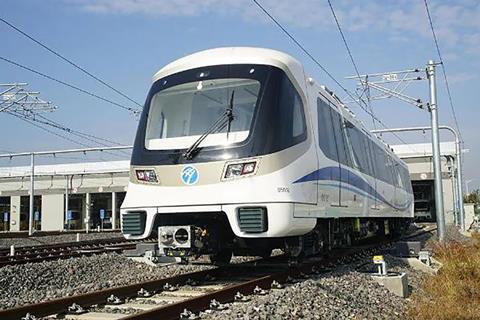
Ningbo goes driverless
In northeast Zhejiang, Ningbo inaugurated its fifth metro Line on December 28, taking the city’s network to a total length of 183 km.
Line 5 is that Ningbo’s first line equipped for driverless operation. Running from Buzheng to Xingzhuang Road, the 27·6 km line has 22 stations, of which five are interchanges. Authorised by the Ningbo Development & Reform Commission in June 2015, the line has been under construction since September 2016. Currently operated as a ‘C’ shaped route, Line 5 is planned to be extended into a complete circle, which would add a further 19·1 km.
The line is worked by a fleet of 26 six-car Type B trains supplied by CRRC Zhuzhou, which were assembled locally in Ningbo. These are powered by permanent magnet synchronous traction motors, saving an estimated 20% of energy compared to the city’s earlier trains with conventional motors.
Services are currently operating between 06.00 and 22.00, with a peak headway of 4½ min and an off-peak frequency of 7 min 40 sec; end-to-end journey time is 48 min.
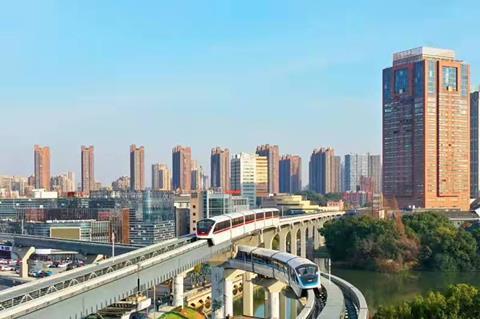
Second monorail
Wuhu’s second straddle-beam monorail line is a 15·8 km east-west route linking Jiuziguangchang and Wanchunhulu, with 11 stations. Interchange to Line 1 is provided at Jiuziguangchang. Most of the line is elevated, but there is a short tunnel section with a single underground station providing serving Wuhu Railway Station.
The monorail worked by a fleet of 18 four-car driverless trainsets manufactured by the CRRC Puzhen Bombardier Transportation Systems joint venture of Alstom and CRRC Nanjing Puzhen.
A 14·4 km western extension to Jiangbei is expected to open in 2025, adding a further eight stations.
Two lines in Tianjin

Tianjin opened two further routes on December 28, taking its expanding network to 265 route-km with 164 stations including 19 interchanges.
The first phase of Line 4 serving the southeast of the city runs from an interchange with Line 2 at Dongnanjiao to Xinxingcun, serving 14 stations including four interchanges. Authorised by the National Development & Reform Commission in 2012, the line has been under construction since August 2013. Work began in mid-2019 on a 23·8 km, 19-station northwestern extension which is expected to open in late 2024.
Line 4 is operated with six-car Type B trainsets manufactured by CRRC Tangshan, which are 118 m long. However, the stations have been built with provision for expansion to eight-car trains of 157 m. End-to-end journey time is 33 min.
The second new route to be inaugurated adds a further 15·3 km and 10 stations to Line 6, serving the city’s southern suburbs. The existing line between Nansunzhuang and Meilinlu has been extended by 900 m to a new interchange at Lushuido, connecting with a standalone suburban route from there to Xianshuiguxi, which is currently branded as part of Line 6 but expected to become part of Line 8 in 2024.

Nanjing Intercity
Branded as suburban Line S6, the 43·6 km Ningju Line in Nanjing is also known as the Nanjing Intercity Railway. Linking Maqun and Jurong with 13 stations, the route is partially underground, but includes a 26·1 km elevated section. Line S6 has been designed and built by the Ningju Rail Transit joint venture between the Nanjing metro operator and Jurong local government; the JV also operates the line.
Designed for 120 km/h operation, Line S6 is worked by a fleet of 33 four-car PM176 Type B trainsets manufactured by CRRC Nanjing Puzhen. The stations have been designed for future expansion to six-car trains.
Also opened in Nanjing on December 28 was a 5·4 km southwestern extension of metro Line 2 with four stations. Approved by the National Development & Reform Commission in May 2015 as part of the Nanjing Urban Rail Transit Construction Plan (2015-20), the partially underground extension takes Line 2 to a total length of 43·4 km.
30-year concession
In the Greater Bay Area, Foshan’s second metro line connects Nanzhuang with Guangzhou Bei Railway Station. With trains running at up to 100 km/h, the end-to-end journey time on the 32·4 km line with 17 stations is 45 min.
Line 2 has been designed and built by a consortium of China Communications Construction Group, Foshan Railway Co and CRRC Sifang under a 30-year BOT concession agreement signed in 2013. CRRC Qingdao Sifang manufactured 25 six-car aluminium-bodied Type B trains, which were assembled locally in Foshan.
Construction of a 23·5 km western extension of Foshan metro Line 2 was formally approved in December.
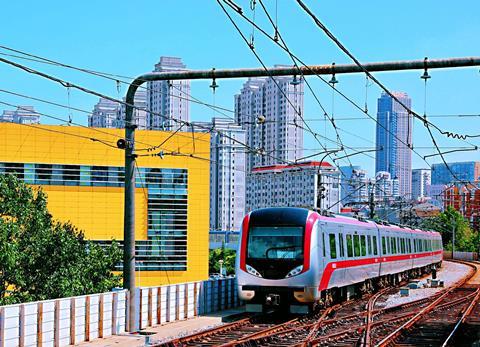
Suburban expansion
The final metro line to open on December 28 was the 43 km Line 13 in the suburbs of Dalian. Under construction since 2010, this is being operated as a northern extension of Line 3’s Jiuli branch to Pulandian Zhenxing Street; it includes a 21·8 km elevated section as well as a 900 m tunnel.
At present through services from Line 13 operate over the Jiuli branch as far as the junction with the rest of Line 3 at Dalian Development Zone. However, longer-term plans envisage the route being extended to Dalian Bei Station on its own tracks.
Line 13 is worked by a fleet of 20 six-car Type B trainsets manufactured by CRRC Dalian. These 120 m long trains are designed for 120 km/h operation, giving an end-to-end journey time of 33 min. The line is equipped for a minimum peak headway of 2 min.
| Metro openings in China on December 28 2021 | ||||
|---|---|---|---|---|
| City | Line | Route | Length km | Stations |
| † section from Lushuidao (one stop east of Meilinlu) to Xianshuiguxi to be absorbed as part of future -Line 8- | ||||
| Shenzhen | 20 | Airport North – Convention & Exhibition City | 8·4 | 5 |
| Wuhu | 2 | Jiuziguangchang – Wanchunhulu, (monorail) | 15·8 | 11 |
| Ningbo | 5 | Buzheng – Xingzhuang Road | 27·6 | 22 |
| Tianjin | 4 | Line 4, Dongnanjiao – Xinxingcun | 19·4 | 14 |
| Tianjin | 6 | Meilinlu – Lushuido † – † Xianshuiguxi | 15·3 | 10 |
| Nanjing | 2 | Youfangqiao – Yuzui | 5·4 | 4 |
| Nanjing | S6 | Maqun – Jurong | 43·6 | 13 |
| Foshan | 2 | Nanzhuang – Guangzhou Bei Railway Station | 32·4 | 17 |
| Dalian | 13 | Jiuli – Pulandian Zhenxing Street | 43·0 | 11 |



